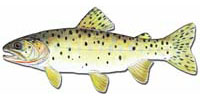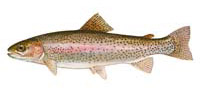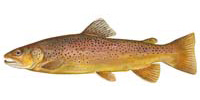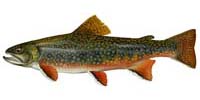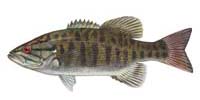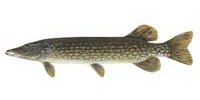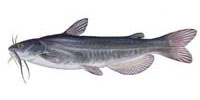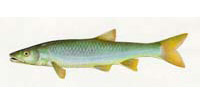If you’d like to fish one of the longest rivers in Montana, pay a visit to Clark Fork River. This river stretches more than 280 miles and offers excellent fishing.You’ll find the river’s best fishing in the section that stretches from its origin point to its convergence with the Flathead River. The river runs parallel to Interstate 90, which allows for easy access to its shores. You’ll find several sections that offer great fly fishing for rainbow and brown trout. The Clark Fork River isn’t well-known for its fishing; however, many people catch huge brown and rainbow trout in its waters each year. You can find other fish here as well, including pike, smallmouth bass, white fish and northern pikeminnow.
The Clark Fork River has several stretches that are home to a variety of fish. Each section offers unique fishing opportunities and requirements.
Upper Clark Fork
From it’s origin in Warm Springs Wildlife Management area to Galen river is narrow, shallow and twisting, with special fishing restrictions. Once the river reaches Galen, it becomes a classic, large spring creek. Casting is usually difficult due to overhanging brush. Fly fishing for the shy brown trout found here requires a quiet, careful approach. Most anglers fish near the three bridge crossings in the area between the origin and Galen. If you take a short walk up or downstream through the thick brush, you may find a stretch of river to call your own.
Cranefly imitations work well in this section of the Upper Clark Fork before the spring runoff (May through late June), as well as early season dry flies like Elk Hair Caddis, Parachute Adams, X-Caddis, and nymphs like the Hare’s Ear and Pheasant Tail. After spring runoff subsides, the Emergent Spark Pupa is a recommended fly, specially developed for the area. Elk Hair Caddis and X-Caddis also work well after run-off. From July through September, hopper imitations are your best bet, followed by Parachute Adams, PMD Cripples, Hare’s Ear and Pheasant Tail Nymphs. Finally, in the fall, large streamers like the Muddler Minnow and the Marabou Muddler will draw brown trout out of hiding.
In the next section of the Upper Clark Fork, From Galen to Deer Lodge, the river expands into a small river, but heavy irrigation and cattle grazing take a toll on fly fishing, and brown trout numbers decrease. The lower part of this section gives way to open fields, clearing out brush and undergrowth, so wading and casting become easier—and preferable for less-experienced fly fisher. The fly and nymph recommendations for Galen to Deer Lodge are the same as the previous section of the river, except that streamers are effective here all summer long because of an increase in the number of bait fish in the waters. County road bridge crossings provides good access to the river in this area.
Middle Clark Fork
From Deer Lodge to Drummond, you will find the largest brown trout on the river. In this stretch, we recommend using streamers like the Muddler Minnow and the Marabou Muddler fished in deeper holes. Fishing access can be found at Kohr’s Bend or at various road crossings throughout this section.
From Drummond to Clinton, Clark Fork fishing is generally poor due to heavy irrigation and warmer water temperatures. However, during fall, some brown trout do make spawning runs.
From Clinton to Missoula, the Rock Creek River and the Blackfoot join Clark Fork, lowering the water’s temperature and increasing its flow. The river gains many riffles and runs, and becomes excellent for fly fishing rainbow, brown and cutthroat trout. Huge hatches will determine your best fishing options. Fishing in this section begins in late May and if the water is clear, salmon fly imitations like the Brooks Stone and Kaufmanns Stone are effective. From mid-June through July, use the Green Drake Emerger and the Olive Sparkle Dun for dry fly fishing, and the Hare’s Ear Nymph for nymph fishing. In late June and July, use Stonefly imitations. After mid-July, hopper imitations work well. As with most other sections of the river, streamers become effective in the fall around the holes. From Clinton to Missoula, there are several designated fishing access sites. The area is heavily used for summertime recreational floating.
Beyond Missoula, Clark Fork enlarges, with solid current and deep waters. Float fishing is the preferable method here, because the best fishing spots are not accessible to waders. The further downstream you travel, the less fishing pressure you will find, but it is still heavily used by recreational floaters. There is also some whitewater between the Petty Creek and Tarkio Access sites to be aware of.
Rainbow trout are the primary fish found beyond Missoula. Though not large in numbers, they can exceed 30 inches. Early season fly fishing begins in April. Fish the Olive Stimulator down deep to take advantage of the skwala stonefly hatch. Spring runoff ends by late June, coinciding with the Gray Drake and Pale Morning Dun hatches.
Parachute Adams, Comparadun, Light Cahill and Elk Hair Caddis, and Hare’s Ear or Pheasant Tail Nymphs. Hopper imitations work well from mid-July through September. In the fall, a Baetis hatch makes the Parachute Adams, Sparkle Dun and Hare’s Ear Nymph good choices. Because fly fishing is spotty in this area, concentrate on areas of top-water activity. There may be several hundred yards of empty water between pockets of fish. Look for seams in the current, as fish like to hold there. A dry fly or nymph floated on the edge of a seam often finds the fish.
Of note, the whitewater section between Petty Creek and Tarkio access sites has a significantly higher trout population than the rest of the lower Clark Fork. The difficulty is reaching it. Wading means a long walk upstream from Tarkio, and floating means contending with fast current and whitewater. Trout here hold to large rocks in the deep pools. Streamers are an effective way to catch the trout, using a sinking line with weights to get the flies down to depth.
Lower Clark Fork
The Lower Clark Fork also provides excellent pike fishing below Plains; anglers use motorboats to access the productive river areas.
Clark Fork River Fish:
Clark Fork River boat ramps:
The following boat ramps provide access to Clark Fork River.
Clark Fork River, St. John’s Fishing Access Site Boat Ramp
Alberton, MT
Directions
Cyr Bridge Fishing Access Site on the Clark Fork River Boat Ramp
1-99 Sawmill Gulch Rd Alberton, MT
Directions


